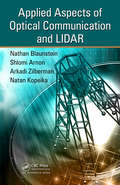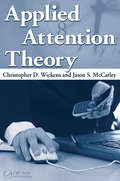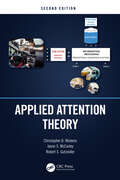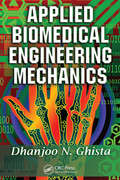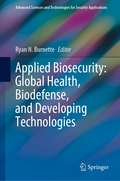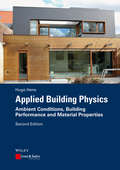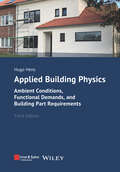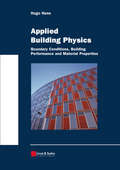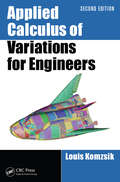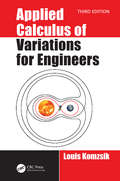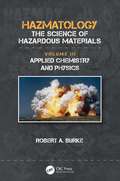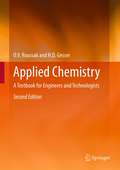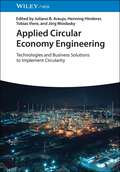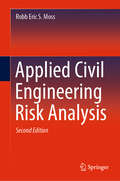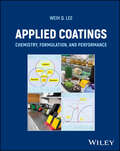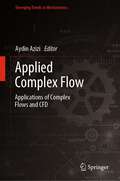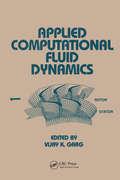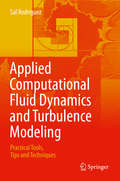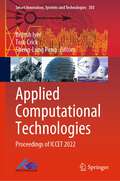- Table View
- List View
Applied Artificial Intelligence: Medicine, Biology, Chemistry, Financial, Games, Engineering (Lecture Notes in Networks and Systems #659)
by Nenad FilipovicThe book is covering knowledge and results in theory, methodology, and applications of artificial intelligence and machine learning in academia and industry. Nowadays, artificial intelligence has been used in every company where intelligence elements are embedded inside sensors, devices, machines, computers and networks. The chapters in this book integrated approach toward global exchange of information on technological advances, scientific innovations, and the effectiveness of various regulatory programs toward AI application in medicine, biology, chemistry, financial, games, law, and engineering. Readers can find AI application in industrial workplace safety, manufacturing systems, medical imaging, biomedical engineering application, different computational paradigm, COVID-19, liver tracking, drug delivery system, and cost-effectiveness analysis. Real examples from academia and industry give beyond state of the art for application of AI and ML in different areas. These chapters are extended papers from the First Serbian International Conference on Applied Artificial Intelligence (SICAAI), which was held in Kragujevac, Serbia, on May 19–20, 2022.
Applied Aspects of Optical Communication and LIDAR
by Nathan Blaunstein Shlomi Arnon Natan Kopeika Arkadi ZilbermanExploring the practical aspects of atmospheric optical communication and light detection and ranging (LIDAR), Applied Aspects of Optical Communication and LIDAR details the role of atmospheric structures in propagation phenomena that influence the transmission of optical signals through perturbed atmospheric communication channels. It examines nume
Applied Attention Theory
by Christopher D. Wickens Jason S. McCarleyEye witness testimony, training, driving, and display design: these are just a few of the real-world domains in which depend on undivided attention. Emphasizing the link between theory and application, Applied Attention Theory provides a deep understanding of how theories of attention, developed from laboratory-based psychological research, can inform our understanding of everyday human performance in a wide number of applications and environments. The basic theories discussed concern divided, focused, and selective attention, and areas of application include mental workload measurement, multi-tasking, distracted driving, complex display design, education, and the training of attentional skills. Includes an extensive reference list and citations to both basic and applied work Provides intuitive descriptions of attentional phenomena in the world beyond the laboratory Discusses applications of attention theory to diverse areas such as graph design, distracted driving, and process control Offers an engineering orientation as well as a psychological orientation to research Highlights the critical role of effort in single task behavior, such as decision and choice, to the extent that humans tend to be effort-conserving in their choice of activities Examines how multiple tasks are managed in a discrete fashion
Applied Attention Theory
by Christopher D. Wickens Jason S. McCarley Robert S. GutzwillerApplied Attention Theory, Second Edition provides details concerning the relevance of all aspects of attention to the world beyond the laboratory. Topic application areas include the design of warning systems to capture attention; attention distractions in the workplace; failures of dividing attention while driving; and the measurement of mental workload while flying. This new edition discusses the implications of VR and AR for human attention. It also covers the treatment of attention-based pedagogical methods used to enhance learning and presents attentional issues in interacting with automation and AI. New chapters include applications of attention to healthcare, education pedagogy, highway safety, and human interaction with autonomous vehicles and other AI systems. The readership for this book is the professional, the researcher, and the student.
Applied Biomedical Engineering Mechanics
by Dhanjoo GhistaPresenting the latest innovations, this text highlights advances in tissue, musculoskeletal, locomotive, orthopedic, occupational, ergonomic, sports, cardiovascular, cardiac, and pulmonary biomechanics. Based on years of teaching experience, the author uses illustrative examples and detailed explanations to show how mechanics disciplines can be applied to a wide range of clinical applications, including the analysis of physiological and organ-system processes; the creation of physiologically compatible organ-assist systems and devices; the performance of pre-surgical analysis in order to develop optimal surgical approaches; and the design of vehicle-occupant systems for occupant comfort.
Applied Biosecurity: Global Health, Biodefense, and Developing Technologies (Advanced Sciences and Technologies for Security Applications)
by Ryan N. BurnetteThis book describes an adaptable biothreat assessment process to complement overall biorisk management programs, incorporating threat management and the unique natures of biological assets. Further, this book examines the nexus between public health, international security, and developing technologies, building a case for augmenting biosecurity to levels beyond the laboratory constraints. With the face of biological and biomedical sciences changing, this book describes how with proper biosecurity development, these can become assets, rather than liabilities, to secure our world from natural and man-made biological disasters. The world is changing rapidly with respect to developing threats, such as terrorism, and dual-use technologies, such as synthetic biology, that are challenging how we think about biosafety and biosecurity. Further, the fields of public health and international security are colliding, as both of these share the common enemy: intentional or natural biological incidents. To date, biosecurity has been limited to laboratory-level application, and complicating efforts, and lacks credentialed biosecurity professionals skilled in both the biological sciences and threat management techniques. The result is a fragmented field of practice, with tremendous need, from the lab to the outbreak. Underpinning these principles is the SARS-CoV-2 coronavirus pandemic, providing a historic milestone to examine biosecurity through a global lens. This book describes biosecurity as a set of practices and principles to be augmented out of the constrained laboratory environment, and applied to larger efforts, such as international threat reduction and biological incident management.
Applied Biotechnology and Bioinformatics: Agriculture, Pharmaceutical Research and Environment
by Swagat Kumar Das Hrudayanath Thatoi Sonali Mohapatra Sukanta Kumar PradhanThis comprehensive reference book discusses the convergent and next-generation technologies for product-derived applications relevant to agriculture, pharmaceuticals, nutraceuticals, and the environment. The field of modern biotechnology is a multidisciplinary and groundbreaking area of biology that includes several cutting-edge methods due to developments in forensics and molecular modeling. Bioinformatics is a full-fledged multidisciplinary field that combines advances in computer and information technology. Numerous applications of bioinformatics—primarily in the areas of gene and protein identification, structural and functional prediction, drug development and design, folding of genes and proteins and their complexity, vaccine design, and organism identification—have contributed to the advancement of biotechnology. Biotechnology is also essential to crop improvement in agriculture because it allows genes to transfer across plants to increase traits such as disease resistance and yield. It also plays a broad role in healthcare, including genetic testing, gene therapy, pharmacogenomics, and drug development. Bioremediation and biodegradation, using microbial technologies to clean up environmental contamination, waste management technologies, and the conversion of organic waste to biofuels. Bioinformatics plays a critical role in analyzing different types of data created by high-throughput research methods—such as genomic, transcriptomic, and proteomic datasets—that are useful in addressing various problems related to disease management, clean environment, alternative energy sources, agricultural productivity, and more. Audience The book will interest biotechnology researchers and bioinformatics professionals working in the areas of applied biotechnology, bioengineering, biomedical sciences, microbiology, agriculture and environmental sciences.
Applied Building Physics and Materials Science of Natural Fiber Reinforced Plastics: A Guide for Study and Practice
by Daniel FriedrichThe transfer of theoretical learning content to the practical application of previously unregulated bio-based building materials is the focus of this technical book. To this end, planning and design principles of thermal, moisture and sound insulation are presented and demonstrated using new types of natural fibre-reinforced plastics (NFK) in façade applications. Results from current research on LFPs and in particular on wood-plastic composites (WPC) are explained in a comprehensible way and presented graphically. It is aimed at students of architecture and civil engineering and offers numerous exam-like exercises and sample solutions to reinforce the contents. Students learn the basics of building physics and practise their application to concrete problems in building design. In addition, they can repeat and consolidate their acquired knowledge in a variety of exercises with a high level of practical relevance. Specialist planners will gain new perspectives on the selection of materials and their use in building components with the potential for more sustainability in the building industry.
Applied Building Physics: Ambient Conditions, Building Performance and Material Properties
by Hugo S. HensBad experiences with construction quality, the energy crises of 1973 and 1979,complaints about `sick buildings?, thermal, acoustical, visual and olfactory discomfort, the need for good air quality, the move towards more sustainability ? all these have accelerated the development of a field that, for a long time, was hardly more than an academic exercise: building physics. The discipline embraces domains such as heat and mass transfer, building acoustics, lighting, indoor environmental quality and energy efficiency. In some countries, fire safety is also included. Through the application of physical knowledge and its combination with information coming from other disciplines, the field helps to understand the physical phenomena governing building parts, building envelope, whole building and built environment performance, although for the last the wording `urban physics? is used. Building physics has a real impact on performance-based building design. This volume on `Applied Building Physics? discusses the heat, air and moisture performance metrics that affect building design, construction and retrofitting.
Applied Building Physics: Ambient Conditions, Functional Demands, and Building Part Requirements
by Hugo S. HensWhile the first volume on building physics deals with the physical principles of heat, air and moisture behaviour of buildings, building structures and components, this second volume on applied building physics focuses on the question of what the desired performance of buildings consists of. To achieve this, knowledge of the external environmental effects and the internal live loads to which buildings are subjected is a necessary first step. Subsequently, the performance requirements and the physical correspondences are deepened with the determination of their physical parameters, at the levels of buildings, building structures and building components. Compared to the second edition, the discussion of criteria is not limited to thermal comfort, but also includes acoustic, visual and olfactory aspects. Likewise, the indoor air quality is considered in a broader way. Analyses and calculations result in sustainable buildings with a comfortable indoor climate from functional and durable building constructions. Compared to the second edition, the text for the third edition has been reorganised, corrected, revised and expanded where appropriate. A useful appendix for quick reference contains standard values of material properties for a wide range of building materials. The analyses and calculations described in this book result in sustainable buildings made of functional and durable building constructions, with comfortable and healthy indoor climate and air quality. Compared to the second edition the text in this third edition has been reshuffled, corrected, reworked and extended where appropriate.
Applied Building Physics: Boundary Conditions, Building Performance and Material Properties
by Hugo S. HensThe energy crises of the 1970s, persisting moisture problems, complaints about sick buildings, thermal, visual and olfactory discomfort, and the move towards more sustainability in building construction have pushed Building Physics to the forefront of building innovation. The societal pressure to diminish energy consumption in buildings without impairing usability acted as a trigger to activate the whole notion of performance based design and construction. As with all engineering sciences, Building Physics is oriented towards application, which is why, after a first book on fundamentals this second volume examines performance rationale and performance requirements. Outdoor and indoor climate conditions are described and calculation values are discussed, the performance concept is specified at the building level and at the building envelope level, and heat-air-moisture material properties are defined. The book incorporates 35 years of teaching Building Physics to architectural, building and civil engineers, bolstered by 40 years of experience, research and consultancy.
Applied Calculus of Variations for Engineers
by Louis KomzsikThe purpose of the calculus of variations is to find optimal solutions to engineering problems whose optimum may be a certain quantity, shape, or function. Applied Calculus of Variations for Engineers addresses this important mathematical area applicable to many engineering disciplines. Its unique, application-oriented approach sets it apart from the theoretical treatises of most texts, as it is aimed at enhancing the engineer’s understanding of the topic.This Second Edition text:Contains new chapters discussing analytic solutions of variational problems and Lagrange-Hamilton equations of motion in depthProvides new sections detailing the boundary integral and finite element methods and their calculation techniquesIncludes enlightening new examples, such as the compression of a beam, the optimal cross section of beam under bending force, the solution of Laplace’s equation, and Poisson’s equation with various methodsApplied Calculus of Variations for Engineers, Second Edition extends the collection of techniques aiding the engineer in the application of the concepts of the calculus of variations.
Applied Calculus of Variations for Engineers, Third edition
by Louis KomzsikCalculus of variations has a long history. Its fundamentals were laid down by icons of mathematics like Euler and Lagrange. It was once heralded as the panacea for all engineering optimization problems by suggesting that allone needed to do was to state a variational problem, apply the appropriate Euler-Lagrange equation and solve the resulting differential equation. This, as most all encompassing solutions, turned out to be not always true and the resulting differential equations are not necessarily easy to solve. On the other hand, many of the differential equations commonly used in various fields of engineering are derived from a variational problem. Hence it is an extremely important topic justifying the new edition of this book. This third edition extends the focus of the book to academia and supports both variational calculus and mathematical modeling classes. The newly added sections, extended explanations, numerous examples and exercises aid the students in learning, the professors in teaching, and the engineers in applying variational concepts.
Applied Chemistry and Physics
by Robert A. BurkeWritten by a hazardous materials consultant with over 40 years of experience in emergency services, the five-volume Hazmatology: The Science of Hazardous Materials suggests a new approach dealing with the most common aspects of hazardous materials, containers, and the affected environment. It focuses on innovations in decontamination, monitoring instruments, and personal protective equipment in a scientific way, utilizing common sense, and takes a risk-benefit approach to hazardous material response. This set provides the reader with a hazardous materials "Tool Box" and a guide for learning which tools to use under what circumstances.Dealing with hazardous materials incidents cannot be accomplished effectively and safely without knowing the effects these materials have. Volume Three, Applied Chemistry and Physics, is not about teaching chemistry and physics. It is about presenting these topics at the level that emergency responders will understand so they can apply the concepts using a risk management system. FEATURES Uses a scientific approach utilizing analysis of previous incidents Offers a risk-benefit approach based upon science and history Provides understanding tools for your Hazmat Tool Box Simplifies physical and chemical characteristics Utilizes chemistry and physics to identify hazards to responders
Applied Chemistry: A Textbook for Engineers and Technologists
by Oleg Roussak H. D. GesserThe second edition of Gesser's classic Applied Chemistry includes updated versions of the original 16 chapters plus two new chapters on semiconductors and nanotechnology. This textbook introduces chemistry students to the applications of their field to engineering design and function across a wide range of subjects, from fuels and polymers to electrochemistry and water treatment. Each chapter concludes with a reading list of relevant books and articles as well as a set of exercises which include problems that extend the topics beyond the text. Other supplements to the text include a laboratory section with step-by-step experiments and a solutions manual for instructors.
Applied Circular Economy Engineering: Technologies and Business Solutions to Implement Circularity
by Tobias Viere Juliano B. Araujo Henning Hinderer Jörg WoidaskyAn essential resource for circular economy engineering as a business sustainability solution and risk mitigation measure In Applied Circular Economy Engineering: Technologies and Business Solutions to Implement Circularity, a team of distinguished researchers delivers an up-to-date discussion of the implementation of circular economy concepts in industrial practice. It examines a comprehensive range of solutions and ideas from engineering and business research from the perspective of the European Circular Economy Package. The book explores the most relevant material and product flows, including metals, polymers, and food, as well as common product lifecycle steps, like product design, material extraction, and recycling. Applied Circular Economy Engineering explains the most effective applied practices, business considerations, and forward-looking solutions to frequently experienced business problems. Readers will also find: A thorough introduction to how circular economy considerations influence process design, product design, energy, and waste managementReal-world case studies of circular design and processesPractical discussions of a wide variety of industries adopting circular economy principles, including medical devices and foodComplete treatments of circular economy implementation and challenges, including business circularity maturity assessments and transition plans Perfect for chemical and process engineers, Applied Circular Economy Engineering: Technologies and Business Solutions to Implement Circularity will also benefit business economists, product planners, and anyone else involved in the engineering and development of circular products or processes.
Applied Civil Engineering Risk Analysis
by Robb Eric MossThis updated edition retains its introduction to applied fundamental statistics, probability, reliability, and decision theory as these pertain to problems in Civil Engineering. The new edition adds an expanded treatment of systems reliability, Bayesian methods, and spatial variabililty, along with additional example problems throughout. The book provides readers with the tools needed to determine the probability of failure, and when multiplied by the consequences of failure, illustrates how to assess the risk of civil engineering problems. Presenting methods for quantifying uncertainty that exists in engineering analysis and design, with an emphasis on fostering more accurate analysis and design, the text is ideal for students and practitioners of a range of civil engineering disciplines. Expands on the class-tested pedagogy from the first edition with more material and more examples;Broadens understanding with simulations coded both in Matlab and in R; Features new chapters on spatial variability and Bayesian methods;Emphasizes techniques for estimating the influence of uncertainty on the probability of failure
Applied Coatings: Chemistry, Formulation, and Performance
by Weih Q. LeeAPPLIED COATINGS An integrated collection of case studies providing a concise guide for professionals working with coatings materials in academia and industry In Applied Coatings: Chemistry, Formulation, and Performance, distinguished scientist Dr. Weih Q. Lee delivers an illuminating collection of case studies designed to connect various elements of applied coatings technology. Going beyond generic discussions, the author describes the fundamental chemistry, formulations, and properties of applied coating materials – including the structural and functional components of structure-property relationships – as well as the foundations of applied cure kinetics and the rheology of epoxy coatings. Each chapter is self-contained, comprehensive, and can be read individually, while the book remains technically and editorially integrated. Core themes include structure-performance relationships, formulation index driven experiment design, and consolidated thermal analysis. Readers will also find: A thorough introduction to epoxies and epoxy curing agents, including oxetanes, vinyl esters, glycidyl methacrylate (GMA), isocyanate and silicone crosslinkers, cationic catalysts, acrylate and phenol accelerators, and specialty derivatives Attentive descriptions of epoxy curing chemistry, including epoxy-phenolic, -polyamide, -active ester, and acid- or base-catalyzed systems in a broader scope Comprehensive explorations of cure kinetics and rheology, including model-free kinetics (MFK), the nth-order model covering Kissinger plots and the Borchardt—Daniels (BD) approach, the autocatalytic model, executive quantification via curve fitting of DSC (differential scanning calorimetry) exotherms, the rheology of non-reactive fluids, and the viscoelasticity of reactive coatings Practical discussions of C1S thick-film surface coatings, C2S structural lamination, liquid and powder epoxies, and phenolic coatings, including fluorene monomers, heterocyclic resins, and polymerizable derivatives Complete treatments of coating characterization, microencapsulation, epoxy hybrids and non-epoxy platforms, adhesion of applied coatings, and adhesion promotion, including reactive and functional silicones Perfect for formulation and research and development scientists and engineers at any technical level, Applied Coatings will also benefit research professors and students studying coatings, adhesives, composites, electronic materials, and more.
Applied Combustion (Mechanical Engineering)
by Eugene L. KeatingThe second edition of this practical text offers a broad introduction to the engineering principles of chemical energy conversion. Eugene L. Keating, Ph.D., P.E., a recognized authority within academia, government, and industry, examines combustion science and technology using fundamental principles. Thermochemical engineering data and design formu
Applied Combustion Diagnostics
by Katharina Kohse-Hoinghaus Jay B. JefferiesThe editors have assembled a world-class group of contributors who address the questions the combustion diagnostic community faces. They are chemists who identify the species to be measured and the interfering substances that may be present; physicists, who push the limits of laser spectroscopy and laser devices and who conceive suitable measuremen
Applied Complex Flow: Applications of Complex Flows and CFD (Emerging Trends in Mechatronics)
by Aydin AziziThis book presents improved numerical techniques and applied computer-aided simulations as a part of emerging trends in mechatronics in all areas related to complex fluids, with particular focus on using a combination of modeling, theory, and simulation to study systems that are complex due to the rheology of fluids (i.e., ceramic pastes, polymer solutions and melts, colloidal suspensions, emulsions, foams, micro-/nanofluids, etc.) and multiphysics phenomena in which the interactions of various effects (thermal, chemical, electric, magnetic, or mechanical) lead to complex dynamics. The areas of applications span materials processing, manufacturing, and biology.
Applied Computational Aerodynamics
by Russell M. Cummings William H. Mason Scott A. Morton David R. Mcdaniel Russell M. Cummings William H. Mason Scott A. MortonThis computational aerodynamics textbook is written at the undergraduate level, based on years of teaching focused on developing the engineering skills required to become an intelligent user of aerodynamic codes. This is done by taking advantage of CA codes that are now available and doing projects to learn the basic numerical and aerodynamic concepts required. This book includes a number of unique features to make studying computational aerodynamics more enjoyable. These include: • The computer programs used in the book's projects are all open source and accessible to students and practicing engineers alike on the book's website, www. cambridge. org/aerodynamics. The site includes access to images, movies, programs, and more • The computational aerodynamics concepts are given relevance by CA Concept Boxes integrated into the chapters to provide realistic asides to the concepts • Readers can see fluids in motion with the Flow Visualization Boxes carefully integrated into the text.
Applied Computational Fluid Dynamics
by Vijay K. Garg"Describes the latest techniques and real-life applications of computational fluid dynamics (CFD) and heat transfer in aeronautics, materials processing and manufacturing, electronic cooling, and environmental control. Includes new material from experienced researchers in the field. Complete with detailed equations for fluid flow and heat transfer.
Applied Computational Fluid Dynamics and Turbulence Modeling: Practical Tools, Tips and Techniques
by Sal RodriguezThis unique text provides engineering students and practicing professionals with a comprehensive set of practical, hands-on guidelines and dozens of step-by-step examples for performing state-of-the-art, reliable computational fluid dynamics (CFD) and turbulence modeling. Key CFD and turbulence programs are included as well. The text first reviews basic CFD theory, and then details advanced applied theories for estimating turbulence, including new algorithms created by the author. The book gives practical advice on selecting appropriate turbulence models and presents best CFD practices for modeling and generating reliable simulations. The author gathered and developed the book’s hundreds of tips, tricks, and examples over three decades of research and development at three national laboratories and at the University of New Mexico—many in print for the first time in this book. The book also places a strong emphasis on recent CFD and turbulence advancements found in the literature over the past five to 10 years. Readers can apply the author’s advice and insights whether using commercial or national laboratory software such as ANSYS Fluent, STAR-CCM, COMSOL, Flownex, SimScale, OpenFOAM, Fuego, KIVA, BIGHORN, or their own computational tools. Applied Computational Fluid Dynamics and Turbulence Modeling is a practical, complementary companion for academic CFD textbooks and senior project courses in mechanical, civil, chemical, and nuclear engineering; senior undergraduate and graduate CFD and turbulence modeling courses; and for professionals developing commercial and research applications.
Applied Computational Technologies: Proceedings of ICCET 2022 (Smart Innovation, Systems and Technologies #303)
by Sheng-Lung Peng Brijesh Iyer Tom CrickThis book is a collection of best selected research papers presented at 7th International Conference on Computing in Engineering and Technology (ICCET 2022), organized by Dr. Babasaheb Ambedkar Technological University, Lonere, India, during February 12 – 13, 2022. Focusing on frontier topics and next-generation technologies, it presents original and innovative research from academics, scientists, students, and engineers alike. The theme of the conference is Applied Information Processing System.

